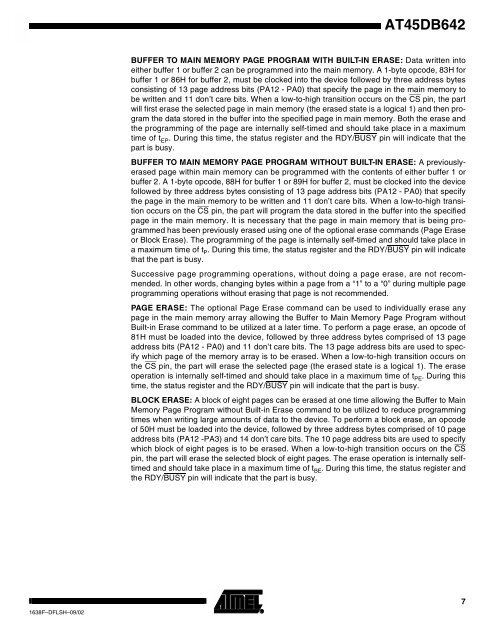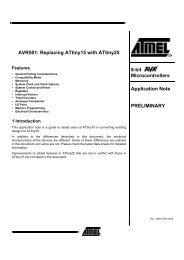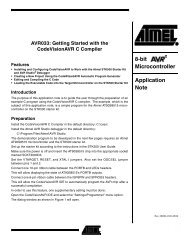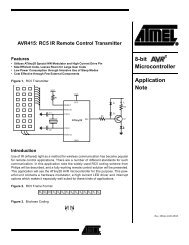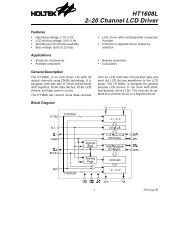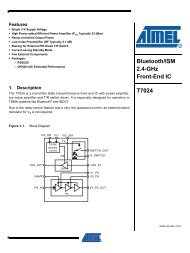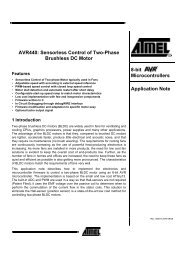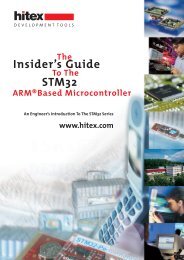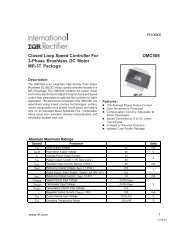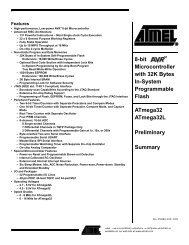64-megabit 2.7-volt Only Dual-interface DataFlash AT45DB642
64-megabit 2.7-volt Only Dual-interface DataFlash AT45DB642
64-megabit 2.7-volt Only Dual-interface DataFlash AT45DB642
- No tags were found...
You also want an ePaper? Increase the reach of your titles
YUMPU automatically turns print PDFs into web optimized ePapers that Google loves.
AT45DB<strong>64</strong>2BUFFER TO MAIN MEMORY PAGE PROGRAM WITH BUILT-IN ERASE: Data written intoeither buffer 1 or buffer 2 can be programmed into the main memory. A 1-byte opcode, 83H forbuffer 1 or 86H for buffer 2, must be clocked into the device followed by three address bytesconsisting of 13 page address bits (PA12 - PA0) that specify the page in the main memory tobe written and 11 don’t care bits. When a low-to-high transition occurs on the CS pin, the partwill first erase the selected page in main memory (the erased state is a logical 1) and then programthe data stored in the buffer into the specified page in main memory. Both the erase andthe programming of the page are internally self-timed and should take place in a maximumtime of t EP . During this time, the status register and the RDY/BUSY pin will indicate that thepart is busy.BUFFER TO MAIN MEMORY PAGE PROGRAM WITHOUT BUILT-IN ERASE: A previouslyerasedpage within main memory can be programmed with the contents of either buffer 1 orbuffer 2. A 1-byte opcode, 88H for buffer 1 or 89H for buffer 2, must be clocked into the devicefollowed by three address bytes consisting of 13 page address bits (PA12 - PA0) that specifythe page in the main memory to be written and 11 don’t care bits. When a low-to-high transitionoccurs on the CS pin, the part will program the data stored in the buffer into the specifiedpage in the main memory. It is necessary that the page in main memory that is being programmedhas been previously erased using one of the optional erase commands (Page Eraseor Block Erase). The programming of the page is internally self-timed and should take place ina maximum time of t P . During this time, the status register and the RDY/BUSY pin will indicatethat the part is busy.Successive page programming operations, without doing a page erase, are not recommended.In other words, changing bytes within a page from a “1” to a “0” during multiple pageprogramming operations without erasing that page is not recommended.PAGE ERASE: The optional Page Erase command can be used to individually erase anypage in the main memory array allowing the Buffer to Main Memory Page Program withoutBuilt-in Erase command to be utilized at a later time. To perform a page erase, an opcode of81H must be loaded into the device, followed by three address bytes comprised of 13 pageaddress bits (PA12 - PA0) and 11 don’t care bits. The 13 page address bits are used to specifywhich page of the memory array is to be erased. When a low-to-high transition occurs onthe CS pin, the part will erase the selected page (the erased state is a logical 1). The eraseoperation is internally self-timed and should take place in a maximum time of t PE . During thistime, the status register and the RDY/BUSY pin will indicate that the part is busy.BLOCK ERASE: A block of eight pages can be erased at one time allowing the Buffer to MainMemory Page Program without Built-in Erase command to be utilized to reduce programmingtimes when writing large amounts of data to the device. To perform a block erase, an opcodeof 50H must be loaded into the device, followed by three address bytes comprised of 10 pageaddress bits (PA12 -PA3) and 14 don’t care bits. The 10 page address bits are used to specifywhich block of eight pages is to be erased. When a low-to-high transition occurs on the CSpin, the part will erase the selected block of eight pages. The erase operation is internally selftimedand should take place in a maximum time of t BE . During this time, the status register andthe RDY/BUSY pin will indicate that the part is busy.1638F–DFLSH–09/027


